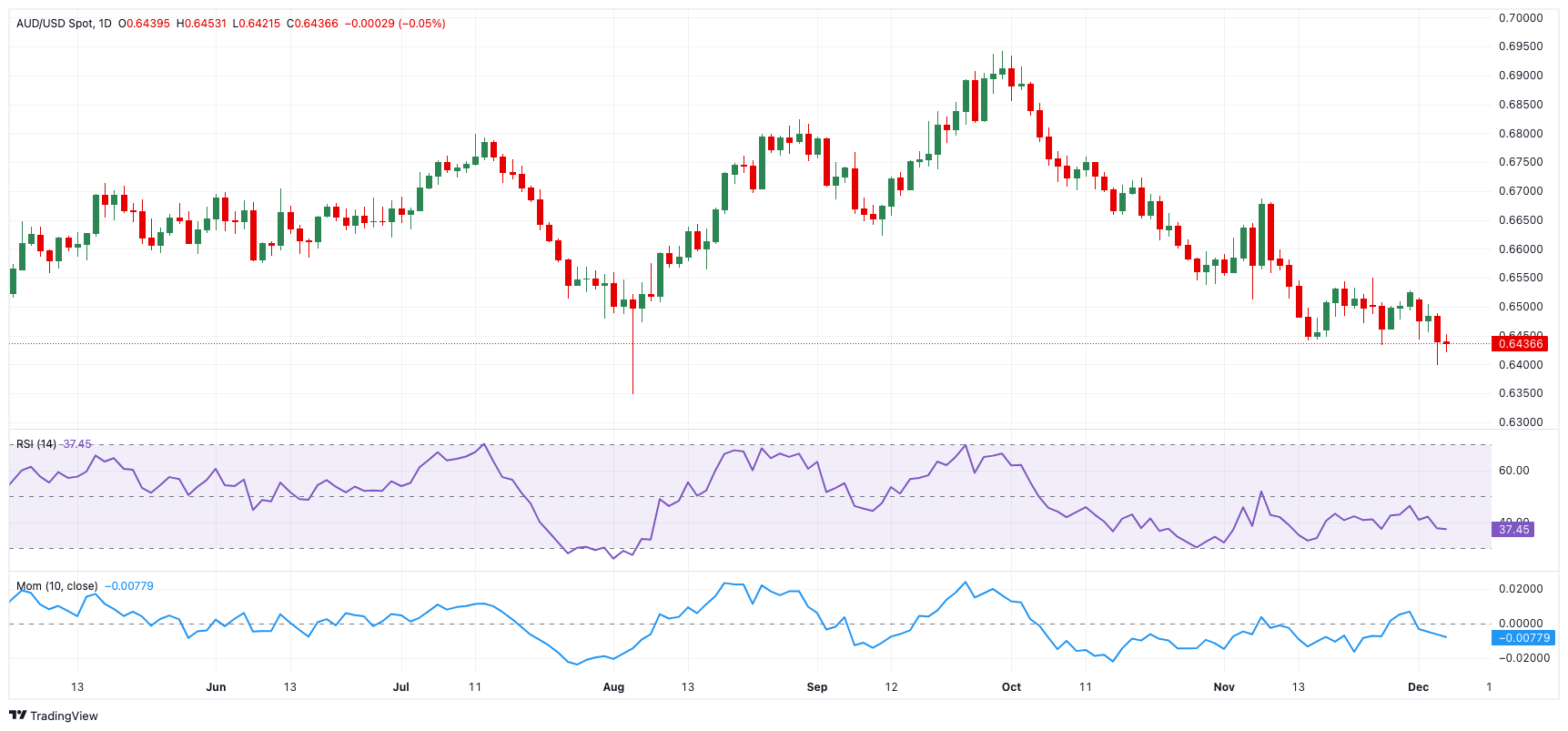- AUD/USD managed to regain the smile and bounce off 0.6400.
- The US Dollar maintained its bearish stance ahead of key US NFP.
- The Australian trade surplus widened above estimates in October.
The US Dollar (USD) continued to face selling pressure on Thursday, extending its losses from the previous day and breaking below the significant 106.00 support level, as reflected in the Dollar Index (DXY).
Meanwhile, the Australian Dollar (AUD) grabbed some fresh breathing room and traded with humble hains near the 0.6450, where some initial resistance seems to have emerged.
Why the Aussie is struggling
The Australian Dollar's recent sharp decline was primarily driven by weaker-than-expected GDP data for the July-September period published on Wednesday. The economy expanded by just 0.3% quarter-on-quarter and 0.8% year-on-year—both falling short of earlier forecasts.
Adding to the downward pressure, key Australian exports like copper and iron ore prices remained well under pressure on the back of ongoing concerns about China’s economy. The Chinese Yuan, too, remained under pressure, weighed down by weak domestic data and renewed tariff threats from the US. As Australia’s economy is closely tied to China’s fortunes, uncertainty lingers over whether Beijing's stimulus measures will stabilize its slowing economy.
The RBA’s cautious approach
Earlier in November, the Reserve Bank of Australia (RBA) opted to keep interest rates steady at 4.35%, maintaining a cautious stance. While tackling inflation remains its top priority, the central bank is wary of exacerbating the country’s economic slowdown. RBA Governor Michele Bullock has emphasized the importance of keeping monetary policy tight until inflation shows sustained signs of easing.
October’s CPI data showed inflation holding steady at 2.1%, but the RBA has warned against making long-term assumptions based on one data point. For now, the central bank appears in no rush to cut rates, with any potential easing unlikely before the second quarter of 2025.
What lies ahead for AUD/USD
The Australian Dollar faces a challenging mix of risks and potential tailwinds. A shift by the US Federal Reserve (Fed) toward rate cuts could provide support for the Aussie, but persistent US inflation and the resilience of the US Dollar remain obstacles. Additionally, China’s economic slowdown continues to weigh heavily on Australia’s outlook, though there are some bright spots: the labour market remains robust, with unemployment steady at 4.1% and 16,000 jobs added in October.
AUD/USD daily chart
Technical outlook for AUD/USD
On the technical front, AUD/USD faces immediate resistance at 0.6549, last seen in late November. Further upside targets include the 200-day Simple Moving Average (SMA) at 0.6625 and November’s high of 0.6687.
On the downside, key support lies at 0.6399, the December low so far, followed by 0.6347, the year’s low from August. These levels could act as safety nets if bearish sentiment deepens.
Momentum indicators paint a cautious picture. The Relative Strength Index (RSI) has rebounded to 41, signaling weakening momentum, while the Average Directional Index (ADX) near 21 suggests a lack of strong trend direction.
Key data to watch
Next on tap Down Under will be the release of Australian Home Loans on Friday.
Bottom line
AUD/USD remains under pressure from a combination of global and domestic headwinds, leaving sentiment fragile. While there’s potential for recovery, much depends on upcoming economic data and developments in the US and China. For now, caution is likely to dominate market sentiment.
Information on these pages contains forward-looking statements that involve risks and uncertainties. Markets and instruments profiled on this page are for informational purposes only and should not in any way come across as a recommendation to buy or sell in these assets. You should do your own thorough research before making any investment decisions. FXStreet does not in any way guarantee that this information is free from mistakes, errors, or material misstatements. It also does not guarantee that this information is of a timely nature. Investing in Open Markets involves a great deal of risk, including the loss of all or a portion of your investment, as well as emotional distress. All risks, losses and costs associated with investing, including total loss of principal, are your responsibility. The views and opinions expressed in this article are those of the authors and do not necessarily reflect the official policy or position of FXStreet nor its advertisers. The author will not be held responsible for information that is found at the end of links posted on this page.
If not otherwise explicitly mentioned in the body of the article, at the time of writing, the author has no position in any stock mentioned in this article and no business relationship with any company mentioned. The author has not received compensation for writing this article, other than from FXStreet.
FXStreet and the author do not provide personalized recommendations. The author makes no representations as to the accuracy, completeness, or suitability of this information. FXStreet and the author will not be liable for any errors, omissions or any losses, injuries or damages arising from this information and its display or use. Errors and omissions excepted.
The author and FXStreet are not registered investment advisors and nothing in this article is intended to be investment advice.
Recommended Content
Editors’ Picks

EUR/USD climbs higher toward 1.1100 ahead of US CPI release
EUR/USD extends its daily rally toward 1.1100 on Thursday as the Euro benefits from the EU's decision to pause countermeasure against US tariffs for 90 days. Meanwhile, the US Dollar remains under pressure ahead of CPI data, further boosting the pair.

GBP/USD trades firm above 1.2850, US CPI data awaited
GBP/USD sustains the rebound above 1.2850 in European trading hours on Thursday. The British Pound capitalizes on risk appetite, courtesy of Trump's tariff pause, allowing the pair to recover ground. But further upside hinges on the US CPI data and US-Sino trade updates.

Gold price enters hotspot region with new all-time high possible
Gold price is delivering a jaw-breaking performance this Thursday in the early trading session, moving around $3,107 at the time of writing. Since Tuesday morning, the precious metal has rallied nearly 5.00%. The main driver for the rally came from the United States President Donald Trump who announced a 90-day pause to higher tariffs on 56 countries and the European Union, which will now be taxed at the 10% baseline rate.

US CPI data set to reveal March inflation dip as markets weigh impact of Trump’s tariffs
As measured by the CPI, inflation in the US is set to rise at an annual pace of 2.6% in March, down slightly from the 2.8% reported in February. Core CPI inflation, which excludes the volatile food and energy categories, is expected to ease to 3% in the same period from a year earlier

Trump’s tariff pause sparks rally – What comes next?
Markets staged a dramatic reversal Wednesday, led by a 12% surge in the Nasdaq and strong gains across major indices, following President Trump’s unexpected decision to pause tariff escalation for non-retaliating trade partners.

The Best brokers to trade EUR/USD
SPONSORED Discover the top brokers for trading EUR/USD in 2025. Our list features brokers with competitive spreads, fast execution, and powerful platforms. Whether you're a beginner or an expert, find the right partner to navigate the dynamic Forex market.
